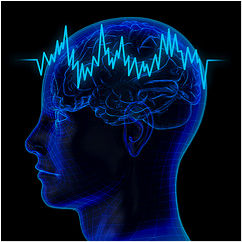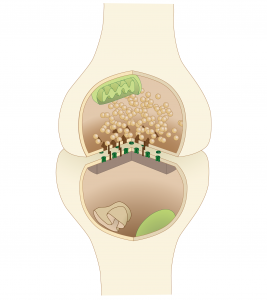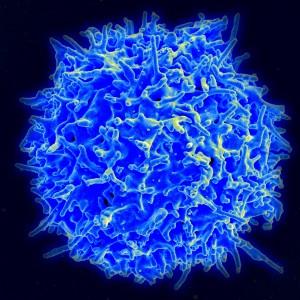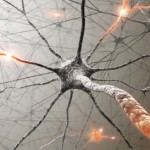Once upon a time, possibly 600 million years ago, a cell became a neuron.
Microbial Mysteries
 Today’s single-celled microbes have capacities that resemble some of the functions of brains, as previous posts have shown. Microbes communicate in groups to make decisions and join with other cells, as if they were part of a multicellular animal. They also have sensory apparatuses that respond to signals concerning heat, light, types of food, and chemicals. These individual cells can respond to new situations, rebuild themselves, and construct elaborate structures; neurons also have all of these capacities.
Today’s single-celled microbes have capacities that resemble some of the functions of brains, as previous posts have shown. Microbes communicate in groups to make decisions and join with other cells, as if they were part of a multicellular animal. They also have sensory apparatuses that respond to signals concerning heat, light, types of food, and chemicals. These individual cells can respond to new situations, rebuild themselves, and construct elaborate structures; neurons also have all of these capacities.
 If a simple organisms such as the microbe has some mental ability to solve problems, communicate in groups, and build structures, then how much greater is the capacity of the enormously more complex, information-carrying, and constantly changing neuron?
If a simple organisms such as the microbe has some mental ability to solve problems, communicate in groups, and build structures, then how much greater is the capacity of the enormously more complex, information-carrying, and constantly changing neuron?
Anatomy of a Neuron
Scientists emphasize the neurons ability to receive information through their branch-like end called a dendrite and transmit some of it to another neuron at the end of a long wire called an axon.
Neurons control electrical signals with complex machinery based upon different types of channels, or holes, along the length of the axon wire. (see post on Complex Machinery in the Neuron). Passing through these holes, charged sodium and potassium ions accumulate either inside or outside the cell, creating an electrical charge, which travels along the length of the axon. Whereas microbes simply release signal chemicals, neurons transmit electrical signals along lengthy wires before releasing signal chemicals, making neuron communication more rapid and accurate than their single-celled counterparts. Neurons communicate in other ways as well. There are electrical junctions between cells. Groups of neurons use synchronous brain waves to communicate information to distant regions of the brain (see post on Synchronous Brain Waves). Even more complex forms of neuronal communication have been found recently. One study found electromagnetic brain waves and currents near individual neurons. Another found cells emitting photons as a communication method (see post on Neuronal Connections and the Mind). 
The hallmark of a neuron is the synapse, or the connection between two cells, which sends a signal across this link between two neurons. The signals are mostly chemicals called neurotransmitters, and, occasionally, a direct electrical impulse that crosses a junction between cells. Although the brain is only 2% of the body’s mass it consumes 20% of the body’s energy, most of which the brain uses at the synapses.
Questioning Current Brain Theory
Current brain theory describes the neuron as an on-off switch that collects data at the dendrites. When the switch is turned on, it sends a signal along the long axon to the next neuron.
The theory suggests that the neuron has no mental capacity of its own. Rather, it participates in the complex circuitry of the brain with a large number of these on-off switches, like a digital computer. In this model it is the network of on-off switches that somehow stores information and makes decisions.
Is this so? Or is it possible that individual neurons are also involved in making decisions, like the much simpler microbe?
 All cells in the human body show remarkable intelligence. Liver, bone, heart, and skin cells replace themselves at exactly the correct rate and show great capacity to perform very specific actions related to their organs’ functions. But the neuron is the most remarkable cell, because it directs all of the other cells, like the conductor of a symphony, relaying information throughout the body for optimum functioning. The neuron also changes to create new receptors almost instantly and maintains active communication with 100,000 other cells—all while somehow participating in consciousness and the mind. (See post on the Rapidly Changing Neuron.)
All cells in the human body show remarkable intelligence. Liver, bone, heart, and skin cells replace themselves at exactly the correct rate and show great capacity to perform very specific actions related to their organs’ functions. But the neuron is the most remarkable cell, because it directs all of the other cells, like the conductor of a symphony, relaying information throughout the body for optimum functioning. The neuron also changes to create new receptors almost instantly and maintains active communication with 100,000 other cells—all while somehow participating in consciousness and the mind. (See post on the Rapidly Changing Neuron.)
The neuron evolved from a simpler microbe to a vastly more complex cell able to be a conduit for mental activity. What is the extent of the neuron’s extremely complex activity? What are the capacities of the individual neuron to make decisions and reorganize itself, and how does this contribute to the brain’s astonishing mental abilities?
